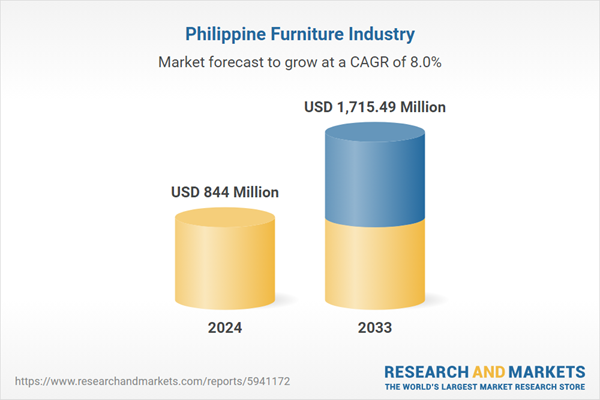Crafted from diverse materials like wood, metal, plastic, and textiles, furniture has evolved from traditional handmade pieces to mass-produced standardized items with the advent of industrialization. It can be categorized based on its intended use: office furniture tailored for workspaces, outdoor furniture engineered for resilience against weather conditions, and residential furniture focused on comfort and style. The design and arrangement of furniture significantly influence the functionality and ambiance of a space.
Currently, furniture is available in a plethora of styles and designs, ranging from classical and ornate to modern and minimalist, across the Philippines. This wide range aims to cater to the diverse needs and preferences of individuals, highlighting the versatility and adaptability of furniture in meeting evolving lifestyle demands.
The market size of Philippines furniture industry reached US$ 780 million in 2023. The growth in market revenue can largely be attributed to the increase in the number of furniture manufacturers and retail outlets. Moreover, rising urbanization has led to increased demand for furniture in residential, hotel, office, and industrial sectors over the period. In addition, increasing customer awareness about online sales and e-commerce portals for furniture, along with the expansion of services offered by e-retailers such as Lorenz Furniture, has also had a significant impact on the Philippine furniture market in recent years.
The country's growing middle-class population, coupled with an increasing GDP, has boosted demand for residential property. This surge in demand for housing structures has been the major driver behind the increased demand for furniture in the country. Home furniture therefore dominated the overall Philippines furniture market in 2023, followed by office, hotel and industrial sector.
The Philippines furniture market is largely dominated by the unorganized sector in terms of the number of manufacturers, with approximately 3,720 unorganized furniture companies operating in the country in 2016. This dominance can be attributed to the abundance of raw materials and the availability of cheap, skilled labor, which have fueled the market's growth. Leveraging locally available resources allows these companies to produce furniture at a lower cost, enabling them to sell products at more competitive prices compared to established companies with multiple retail outlets in the Philippines.
In the Philippines, furniture sales have primarily been dominated by offline retail outlets, franchisee outlets, showrooms, and exclusive stores operated by manufacturers and major players in the industry. Despite the country having approximately 69.05 million internet users in 2023, online sales of furniture made only a minor contribution to overall market revenues. In 2023, brick-and-mortar stores continued to pose significant competition to online players in the Philippines furniture market. These physical retail outlets offered a diverse range of products at competitive prices, attracting a large portion of consumers. Consequently, online sales accounted for only a minor fraction, representing approximately 26.5% of the total sales revenue in the furniture market.
The publisher predicts that the furniture industry of Philippines will grow rapidly during the forecast period (2024-2033). Rise in domestic as well export demand of furniture products is anticipated to result in market growth. Since tourism-based enterprises such as hotels, restaurants, museums and leisure service providers face growing needs to update their amenities; the demand for unique furniture items is expected to rise sharply. Apart from the robust hotel sector, construction of more condominiums and residential houses in the country is expected to drive the growth of the industry in the coming years. The property sector’s strong growth and families’ easier access to housing credit will also increase demand for household items and most importantly furniture products.
According to the publisher, the furniture industry of Philippines is poised for significant growth, with expectations to reach a market value of US$ 1,715 million in 2033, with a compound annual growth rate of 8.2% from 2024 to 2033. Additionally, the export value of Philippine furniture is forecasted to reach US$ 3 billion in 2033, reflecting a growth rate of 5.5%.
Topics covered:
- Philippines Furniture Industry Overview
- The economic and policy environment of Philippines's furniture industry
- Philippines Furniture Industry Market Size, 2024-2033
- Analysis of the main Philippines furniture production enterprises
- Key drivers and market opportunities for Philippines's furniture industry
- What are the key drivers, challenges and opportunities for Philippines's furniture industry during the forecast period 2024-2033?
- Which companies are the key players in the Philippines furniture industry market and what are their competitive advantages?
- What is the expected revenue of Philippines furniture industry market during the forecast period 2024-2033?
- What are the strategies adopted by the key players in the market to increase their market share in the industry?
- Which segment of the Philippines furniture industry market is expected to dominate the market by 2032?
- What are the main negative factors facing the furniture industry in Philippines?
Table of Contents
Companies Mentioned
- IKEA
- West Elm
- Pottery Barn
- Ethan Allen
- Dimensione
- Mandaue Foam
- Crate & Barrel Philippines
- SM Home
- MOD Living Furnishing
- Trunc
Methodology
Background research defines the range of products and industries, which proposes the key points of the research. Proper classification will help clients understand the industry and products in the report.
Secondhand material research is a necessary way to push the project into fast progress. The analyst always chooses the data source carefully. Most secondhand data they quote is sourced from an authority in a specific industry or public data source from governments, industrial associations, etc. For some new or niche fields, they also "double-check" data sources and logics before they show them to clients.
Primary research is the key to solve questions, which largely influence the research outputs. The analyst may use methods like mathematics, logical reasoning, scenario thinking, to confirm key data and make the data credible.
The data model is an important analysis method. Calculating through data models with different factors weights can guarantee the outputs objective.
The analyst optimizes the following methods and steps in executing research projects and also forms many special information gathering and processing methods.
1. Analyze the life cycle of the industry to understand the development phase and space.
2. Grasp the key indexes evaluating the market to position clients in the market and formulate development plans
3. Economic, political, social and cultural factors
4. Competitors like a mirror that reflects the overall market and also market differences.
5. Inside and outside the industry, upstream and downstream of the industry chain, show inner competitions
6. Proper estimation of the future is good guidance for strategic planning.

LOADING...
Table Information
| Report Attribute | Details |
|---|---|
| No. of Pages | 60 |
| Published | February 2024 |
| Forecast Period | 2024 - 2033 |
| Estimated Market Value ( USD | $ 844 Million |
| Forecasted Market Value ( USD | $ 1715.49 Million |
| Compound Annual Growth Rate | 8.0% |
| Regions Covered | Philippines |
| No. of Companies Mentioned | 10 |









